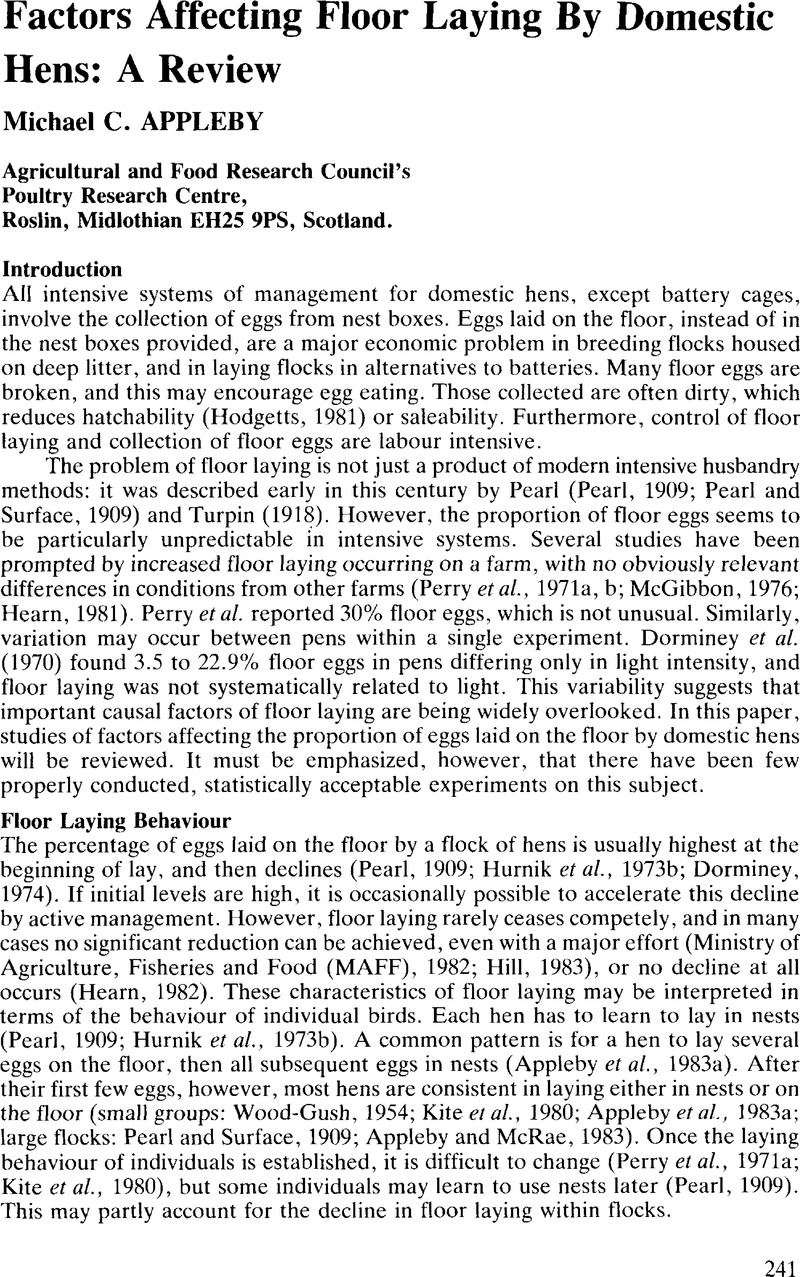Crossref Citations
This article has been cited by the following publications. This list is generated based on data provided by Crossref.
APPLEBY, MICHAEL C.
1986.
Hormones and Husbandry: Control of Nesting Behavior in Poultry Production.
Poultry Science,
Vol. 65,
Issue. 12,
p.
2352.
Nicol, C.J.
1986.
Non-exclusive spatial preference in the laying hen.
Applied Animal Behaviour Science,
Vol. 15,
Issue. 4,
p.
337.
BRAKE, J.
1987.
Influence of Presence of Perches During Rearing on Incidence of Floor Laying in Broiler Breeders.
Poultry Science,
Vol. 66,
Issue. 10,
p.
1587.
Karunajeewa, H.
1987.
A review of current poultry feeding systems and their potential acceptability to animal welfarists.
World's Poultry Science Journal,
Vol. 43,
Issue. 1,
p.
20.
Appleby, M. C.
Duncan, I. J. H.
and
McRae, Helen E.
1988.
Perching and floor laying by domestic hens: Experimental results and their commercial application.
British Poultry Science,
Vol. 29,
Issue. 2,
p.
351.
Duncan, I.J.H.
and
Kite, V.G.
1989.
Nest site selection and nest-building behaviour in domestic fowl.
Animal Behaviour,
Vol. 37,
Issue. ,
p.
215.
Appleby, M.C.
and
Hughes, B.O.
1991.
Welfare of laying hens in cages and alternative systems: environmental, physical and behavioural aspects.
World's Poultry Science Journal,
Vol. 47,
Issue. 2,
p.
109.
Appleby, M. C.
and
Smith, S. F.
1991.
Design of nest boxes for laying cages.
British Poultry Science,
Vol. 32,
Issue. 4,
p.
667.
Reed, H. J.
and
Nicol, C. J.
1992.
Effects of nest linings, pecking strips and partitioning on nest use and behaviour in modified battery cages.
British Poultry Science,
Vol. 33,
Issue. 4,
p.
719.
Petherick, J. C.
Seawright, E.
and
Waddington, D.
1993.
Influence of quantity of utter on nest box selection and nesting behaviour of domestic hens.
British Poultry Science,
Vol. 34,
Issue. 5,
p.
857.
Smith, S. F.
Appleby, M. C.
and
Hughes, B. O.
1993.
Nesting and dust bathing by hens in cages: Matching and mis‐matching between behaviour and environment.
British Poultry Science,
Vol. 34,
Issue. 1,
p.
21.
Beattie, V.E.
Walker, N.
and
Sneddon, I.A.
1995.
Effect of rearing environment and change of environment on the behaviour of gilts.
Applied Animal Behaviour Science,
Vol. 46,
Issue. 1-2,
p.
57.
TAYLOR, ALLISON A.
and
HURNIK, J. FRANK
1996.
The Long-Term Productivity of Hens Housed in Battery Cages and an Aviary.
Poultry Science,
Vol. 75,
Issue. 1,
p.
47.
Cooper, J. J.
and
Appleby, M. C.
1996.
Individual variation in prelaying behaviour and the incidence of floor eggs.
British Poultry Science,
Vol. 37,
Issue. 2,
p.
245.
COOPER, JONATHAN J.
and
APPLEBY, MICHAEL C.
1997.
Motivational aspects of individual variation in response to nestboxes by laying hens.
Animal Behaviour,
Vol. 54,
Issue. 5,
p.
1245.
Appleby, Michael C.
1997.
Life in a variable world: Behaviour, welfare and environmental design.
Applied Animal Behaviour Science,
Vol. 54,
Issue. 1,
p.
1.
GUNNARSSON, S.
1999.
Effect of rearing factors on the prevalence of floor eggs, cloacal cannibalism and feather pecking in commercial flocks of loose housed laying hens.
British Poultry Science,
Vol. 40,
Issue. 1,
p.
12.
Horsted, K.
and
Hermansen, J.E.
2007.
Whole wheat versus mixed layer diet as supplementary feed to layers foraging a sequence of different forage crops.
Animal,
Vol. 1,
Issue. 4,
p.
575.
Pilotto, Fernando
Ribeiro, Andréa Machado Leal
Cargnelutti Filho, Alberto
and
Klein, Vilson Antonio
2010.
Efeito da transformação do ninho manual modelo holandês em mecânico na postura de ovos de cama em matrizes de frangos de corte.
Revista Brasileira de Zootecnia,
Vol. 39,
Issue. 10,
p.
2310.
Stämpfli, Karin
Roth, Beatrice A.
Buchwalder, Theres
and
Fröhlich, Ernst K.F.
2011.
Influence of nest-floor slope on the nest choice of laying hens.
Applied Animal Behaviour Science,
Vol. 135,
Issue. 4,
p.
286.





